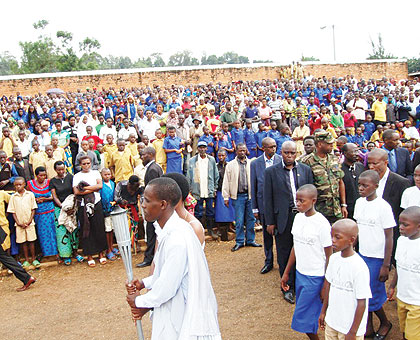ONCE YOU MOVE past the old dark-brown gates that stand between the ageing walls of Rusizi stadium, the rough terrain that welcomes you and the irregular overgrown grass at the football ground are testimony of the pitch’s age.


ONCE YOU MOVE past the old dark-brown gates that stand between the ageing walls of Rusizi stadium, the rough terrain that welcomes you and the irregular overgrown grass at the football ground are testimony of the pitch’s age.
Built years before the 1994 Genocide against the Tutsi, the stadium, named Kamarampaka (literary meaning the dispute-resolver) stands in the middle of banana plantations outside Kamembe town.
For sports lovers and those unfamiliar with the stadium’s history, Kamarampaka is just a place of leisure and entertainment. But for survivors of the 1994 Genocide against the Tutsi, the place reminds them of their loved ones who were killed during the pogrom.
When killings erupted in April 1994, thousands of Tutsis fled their homes and gathered at places they thought were safe. These included churches, stadiums and other public places. Hundreds gathered at Cyangugu Catholic Church, just a few metres from the stadium. In the days that followed, the fleeing Tutsis were tricked into leaving the Church. They were advised to move to the stadium with promise that it would be easier to guarantee their security there.
Eyewitnesses recall that after thousands of Tutsis were ‘herded’ into the stadium, they were barred from getting out. Those who attempted to flee were either forcifully returned or killed.
"This stadium was turned into a butcher house,” says Thacien Gatete, 55, a survivor who was among the many Tutsi forced into the stadium.
Survivors recall incidents which saw some men and young boys taken away and murdered by soldiers and militia men.
"At the beginning, killings were selective,” says Gatete.
In one incident, Gatete was bundled on to a waiting vehicle by killers who had mistaken him for a wealthy businessman with the same name. He was later ordered to climb down the vehicle as it emerged that he was not the person the killers wanted.
"They possessed a list of people they wanted to kill. They took them away and murdered them,” says Gatete.
In one such incident, soldiers and the interahamwe militia took hundreds of individuals from the thousands trapped at Cyangugu stadium, pushed them into buses and drove into the countryside where they were all murdered, according to testimonies.
Christine Mukakayijuka, also a Genocide survivor, still remembers the day his husband was taken away. It was May 7, 1994, she remembers with grief.
"They pushed him out of the stadium and took him to Gatandara, a few metres from Rusizi Stadium where he was killed,” she says with bitterness.
Bagambiki and the other ‘instrumental leaders’
It is alleged that killings in Cyangugu, particularly at Rusizi Stadium, were spearheaded by former leaders. The most cited among them include former Prefect Emmanuel Bagambiki, Lt. Samuel Imanishimwe, the commander of the Cyangugu military barracks until July 1994, and Simeon Ncamihigo who was the Deputy Prosecutor for Cyangugu Prefecture.
Bagambiki was the Préfect (governor) of Cyangugu between 1992 and July 1994.
Under an indictment issued by the International Criminal Tribunal for Rwanda (ICTR), Bagambiki was arrested and charged with genocide, complicity in genocide, conspiracy to commit genocide, crimes against humanity and war crimes.
The prosecution charged that Bagambiki was responsible for distributing arms to the Interahamwe militia, preparing lists of civilians to be killed and inciting the killing of Tutsis.
The accusations led to his arrest in 1988 and subsequent trial which was heard between 2000 and 2004. After four years of trial, Bagambiki was found not guilty and acquitted. In 2006, the Appeals Chamber upheld his acquittal.
However, the court’s decision sparked protests from survivors who accuse him of participating in the Genocide. Survivors are still enraged by his acquittal and are yet to come to terms with it.
"I am convinced that thousands of Tutsis were killed on Bagambiki’s orders,” says Gatete.
"He was a senior commander of the militia. He presided over the killings,” says Gatete, adding that the court’s decision is absurd.
However, Lt. Samuel Imanishimwe and Simeon Ncamihigo were both convicted for their role in the Cyangugu massacres.
Heroic individuals
Apart from the people who are accused of having helped the Interahamwe militia to hunt down and kill Tutsis in the former Cyangugu prefecture, a number of other people have been hailed for their efforts to protect those who were being killed.
One such individual is Lt. Colonel Innocent Bavugamenshi who is said to have opposed a plan to kill over 10,000 Tutsis who had gathered at Nyarushishi camp.
It is believed that most of these individuals were saved from slaughter only because the gendarmes guarding the camp were under the command of Bavugamenshi.
Father Oscar Nkundayezu is also said to have defied the militia and delivered food to the Tutsis at Kamarampaka stadium.
Another person hailed as a ‘hero’ of Cyangugu is Father Baudouin Busunyu of Nkanka Parish whom Gatete said helped many Tutsis to flee to the neighbouring DR Congo after killings erupted.


